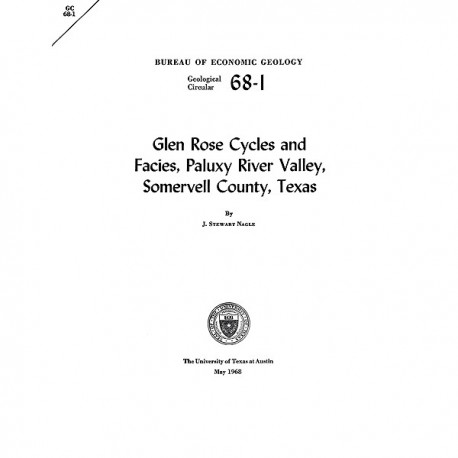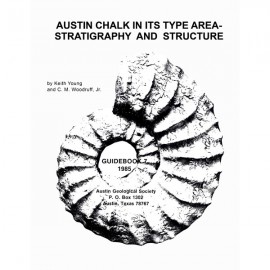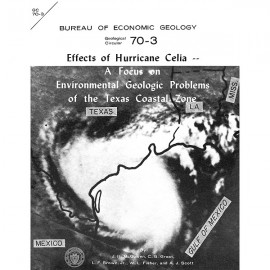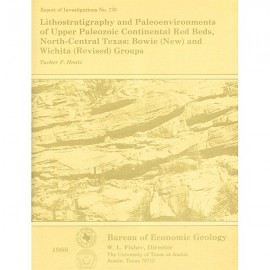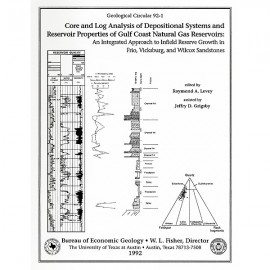Geological Circulars
-
Books & Reports
- Reports of Investigations
- Guidebooks
- Udden Series
- Geological Circulars
- Down To Earth
- Atlases of Major Oil and Gas Reservoirs
- Texas Memorial Museum Publications
- Environmental Geologic Atlas of the Texas Coastal Zone
- Mineral Resource Circulars
- Other Reports
- Seminars and Workshops
- Handbooks
- Submerged Lands of Texas
- Symposia
- Annual Reports
- Open File Reports
-
Maps & Cross Sections
- Thematic Maps
- Miscellaneous Maps, Charts & Sections
- Geologic Atlas of Texas
- STATEMAP Project Maps
- Geologic Quadrangle Maps
- Cross Sections
- Highway Geology Map
- Energy and Mineral Resource Maps
- Shoreline Change and Other Posters
- Wilcox Group, East Texas, Geological / Hydrological Folios
- Bouguer Gravity Atlas of Texas
- River Basin Regional Studies
- Featured Maps
- Posters
- Teachers & the Public
-
Geological Society Publications
- Gulf Coast Association of Geological Societies
- Alabama Geological Society
- Austin Geological Society
- Corpus Christi Geological Society
- Houston Geological Society
- Lafayette Geological Society
- Mississippi Geological Society
- New Orleans Geological Society
- South Texas Geological Society
- GCS SEPM Publications
- Historic BEG & UT Series
Glen Rose Cycles and Facies, Paluxy River Valley, Somervell County, Texas
GC6801
A free, digital version of this publication can be found on: Texas ScholarWorks
GC6801. Glen Rose Cycles and Facies, Paluxy River Valley, Somervell County, Texas, by J. S. Nagle. 25 p., 7 figs., 1968. ISSN: 0082-3309. Print.
To purchase this publicaton as a PDF download, please order GC6801D.
ABSTRACT
Paleoenvironmental analysis of the alternating beds of the basal Cretaceous Glen Rose Formation in Central Texas indicates a cyclical alternation of subtidal through supratidal facies. These facies were reconstructed through detailed analysis of lithology, biota (including macrofauna, microfauna, ichnofauna, and macroflora), detrital shell dispersal, and primary sedimentary structures. Facies succession indicates that each cycle represents a subtidal to supratidal depositional regime transit; cycles are regressional, with the transgressional phase being poorly developed, if at all. This conclusion is in agreement with results of studies of the Holocene transgression, which reveal a regressional succession developed by progradation of shorelines. Some other formations show similar depositional regime transit cycles; hence the Glen Rose model may be widely applicable.
Facies variations within and between cycles indicate (1) that there is no typical or ideal cycle, (2) that the cycles record successive sedimentation units within a marginal marine hypersaline lagoon or bay system, and (3) that depositional regime transit cycles have limited correlation value. Facies in the seven cycles in the lower Glen Rose, Paluxy Valley, include subtidal to supratidal flat deposits, marsh, flood plain, shoal patch reef, bay, marsh island, and shifting sand lobe deposits; the only typical aspect of the cycles is their general subtidal to supratidal succession. Mixed terrestrial, marginal marine, and marine faunas and floras within these facies tracts indicate that the lower Glen Rose in this area is a lagoonal or bay depositional system. Paucity of terrigenous elastics, abundance of evaporites, presence of serpulid-patch reefs, and relatively low diversity of faunas with an abundance of thick-shelled ostracods indicate that at least the earlier phases of the lagoonal system were hypersaline.
Areal stratigraphic correlation of these depositional regime transit cycles is unwise because the cycles tend to proliferate downdip, and because units that could be used as key beds commonly are local in extent. These beds reflect similar depositional conditions which recur in homotaxial phases of different cycles; indeed potential key beds may change facies within a few miles, even when bed thickness remains nearly constant. Correlation by matching cycles in sections less than a mile apart, however, is feasible.
Several particulars are useful in recognizing position in the cycle. Burrow fillings change upwards from lime-mud to sparry calcite or dolomite--a reflection of diagenetic regime. Burrows with unlithified or partially indurated calcite mud and shells occur in subtidal sediments. Diagenetically modified burrows first appear in or above the zone of sorted and abraded shell, inferred to be the wave or beach zone. Diagenetic burrow modification is intrastratal; this plus the dense fabric with unaltered shells indicate early, soft sediment diagenesis. Paleoenvironmental evidence plus studies of the Recent support the idea that these diagenetic modifications are associated with exposure and solutional modification, dolomite by hypersalinity, sparry calcite by fresh water. Subtidal deposits contain articulated and unsorted shells, many in living position; nearshore wave zone or intertidal shells occur in beds of well-sorted and abraded detrital plates. Supratidal deposits abound in rollers or may contain abraded detrital plates in texturally inverted sediments. Supratidal marshes contain abundant remains of the plant Frenelopsis. Its tiny cells, thick epiderm, protected stomata, and poorly developed roots indicate it is a physiological xerophyte similar to Salicornia of present-day salt marshes.
Keywords: Glen Rose Formation, facies, Paluxy River Valley, Somervell County, Texas
CONTENTS
Abstract
Introduction
Cycles in vertical profile
Members of the Glen Rose cycle
Fades relations within individual cycles
Corbula-bed cycle
Serpulid-reef cycle
Marsh-land cycles
Sand-delta cycle
Miliolid-sand and mussel-marsh cycles
Summary and conclusions
Acknowledgments
References cited
Figures
1. Index map showing location of measured sections, Somervell and Hood counties
2. Measured section SV-5, Cedar Brake Camp, showing bed-for-bed changes in lithology and paleontology
3. Facies changes within the Corbula-bed cycle
4. Fades changes within the serpulid-reef cycle
5. Facies reconstruction of marsh-land cycles
6. Reconstruction of facies in sand-delta cycle
7. Facies interpretations, miliolid-sand and marsh mussel cycles
Citation
Nagle, J. S., 1968, Glen Rose Cycles and Facies, Paluxy River Valley, Somervell County, Texas: The University of Texas at Austin, Bureau of Eonomic Geology, Geological Circular 68-1, 25 p.
